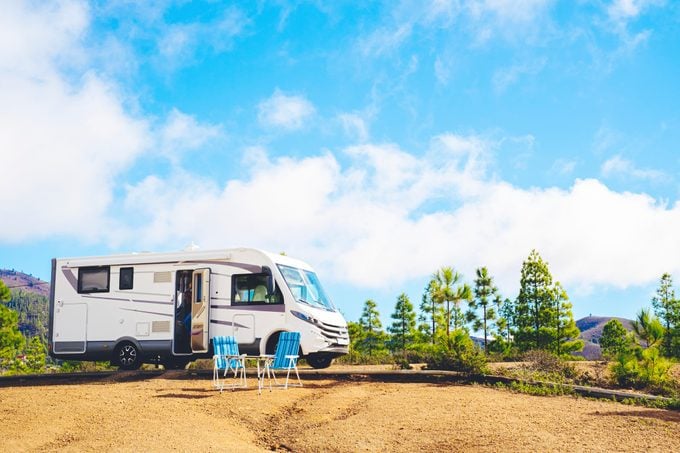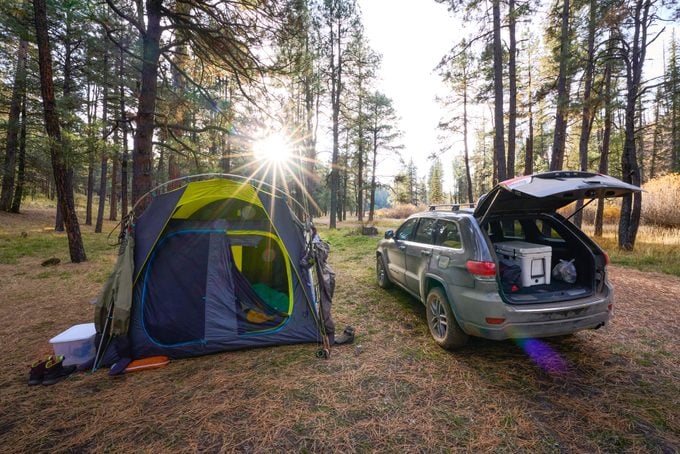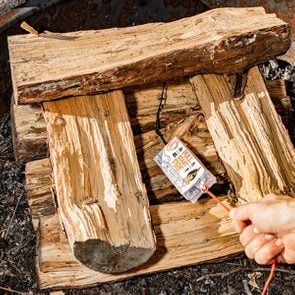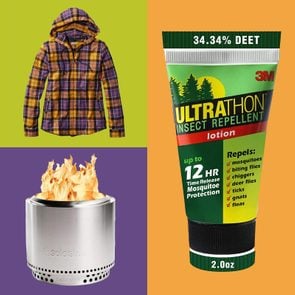How to Camp for Free in the United States
Updated: Oct. 08, 2023

On a tight budget? You'll definitely want to learn the ins and outs of free camping—including where to find the perfect destination near you.
For people who love the outdoors, it’s a no-brainer that camping is one of the best ways to enjoy nature and some breathing room. Not surprisingly, interest in camping surged during the pandemic and has remained at record levels since—in 2022, 6.4 million households tried camping for the first time, according to a KOA report. But camping isn’t just a great way to get away from the hubbub of daily life and enjoy some peace and quiet, it’s also a budget-friendly vacation option. Free camping is especially easy on the wallet, if you find a destination that doesn’t charge a fee. Yes, you read that right—free camping is possible in many places throughout the United States; you just need to know where to look. Get started by finding out exactly what qualifies as free camping, including car camping and national park camping. Once you understand exactly what qualifies as free camping, along with some important guidelines for camping for beginners, you can check out the most scenic campsites in every state and start planning your adventure.
I first started camping about 10 years ago, and while I’ve enjoyed some proper paid campsites that ensured I could set up when and where I wanted to, and even some glampsites, the majority of my trips have involved free camping, including backcountry backpacking in New York’s Adirondack Mountains and car camping in Wisconsin’s national forests. Read on to learn everything you need to know about free camping.
What is free camping?
Free camping is, essentially, just what the name suggests: camping for free, without having to pay any money to stay at a campsite. It can take several forms and be part of a car- or RV-based road trip or part of an extended backpacking or bike-packing trip.
Free camping should not be confused with more wild forms of camping, such as dispersed camping and primitive camping, which center around being in off-the-grid wilderness areas that are away from the services and amenities found at more developed campgrounds and RV parks.
Car camping: This refers to camping with your car nearby and could include setting up a tent right outside your car or even sleeping in your car.
Dispersed camping: Camping outside of designated campsites. This might include camping on public land in national forests or owned by the Bureau of Land Management.
Boondocking: This term typically refers to dispersed camping in a RV, camping on public land, away from designated campsites, without sewers, water or electricity hookups.
Dry camping: Similar to boondocking, dry camping involves being self-contained, setting up an RV with no hookups, but at a traditional campground.
Primitive camping: Remote camping without man-made structures and amenities.
Note that when camping in an area that’s not being supported by admissions or permit fees, you may not have access to water, electricity and bathrooms, and you’ll want to be clear about that before taking your trip so you can plan accordingly.

Can you camp for free anywhere?
No, you cannot. While many national and state parks and forest areas do set aside areas for free camping, many also require campers to pay a nominal fee that helps support the maintenance of the area. Some campgrounds may also require a reservation, so confirm whether that’s the case before heading out on your trip. This information really comes in handy if you’re planning any national park road trips.
Camping on private land is also prohibited, so just because a chunk of land looks wide open and free, it doesn’t mean that it actually is. Somebody or some entity (an individual, corporation or government entity) may own that land, and they might not want you camping on it. If setting up camp near an ocean or lake sounds heavenly to you, try these great spots for beach camping.
Where can I set up a tent for free?
According to Mary Monroe Brown, director of the Wisconsin Office of Outdoor Recreation, different sites have different rules about where you can—and can’t—camp. Some parks and forests allow free camping anywhere other than where a sign prohibits it. Other areas, like the Chequamegon-Nicolet National Forest in northern Wisconsin, specify exactly where you cannot camp and require campers to be 200 feet from the water and 150 feet from any trail or service road.
Note that some sites limit how long you can camp there, as well. Most Bureau of Land Management sites cap free camping to 14 to 30 days, though the amount of time varies by location. Most national forests allow dispersed camping up to 14 days, though some areas are limited to one day, while others allow up to 30 days. These sites tend to be great options for different types of RVs.
National parks are typically too crowded to allow free camping, or even paid camping without a reservation. However, some do allow backcountry or dispersed camping, though you may need to obtain a free permit.
Regardless of where you plan to camp, check the local regulations by stopping by the ranger station or calling ahead of your stay.
How to find free camping
There are many ways to search for free camping online. However, no online resources currently exist that show whether a free campsite has been claimed, but you could call the local tourism board or park/forest information center and ask for a recommendation of campsites that tend to be less popular. Weekends and holidays tend to be the busiest, so you’ll have the best luck finding a free campsite midweek. You should also keep in mind that national parks are very popular with campers, so it’s a good idea to plan in advance and have a backup plan in case nothing is available. Ready to get started? These are the best places to camp in national parks.
Here are some resources to find free campsites:
- Campendium: This app allows you to search for campsites all over the country, and you can set the price to “free” to filter out paid campsites.
- National Forests: These are easy to find on Google Maps, and the United States Forest Service (USFS) website has an interactive map that shows hiking trails, campsites and ADA-accessible areas.
- Bureau of Land Management: The BLM manages public land and is an especially good place to find free overnight parking for your RV.
- Recreation.gov: This website (and mobile app) is a great resource for finding federal campgrounds, such as BLM and U.S. Forest Service sites.
- iOverlander: This volunteer-run project is helpful for finding off-the-grid and free places to camp.
- Overnight RV Parking: This is a database of places where you can stay in your vehicle overnight, including parking lots. It requires an annual $49 membership fee.
- Boondockers Welcome: For a $79 membership fee, this website connects RVers with private hosts around the United States who allow you to park on their property at no charge.
Another good source for free camping information is the websites of local tourism boards, state departments of natural resources and state departments of environmental conservation.

What to know before camping for free
Free campsites can be extremely hard to come by during peak summer months because many operate on a first-come, first-served basis. To get a good spot, plan to arrive early in the day, but know that you still run the risk of not finding an available free campsite. Before hitting the road, make a list of several other potential camping and accommodation options in the area, should your ideal free campsite not be available.
The free campsites that tend to go quickest are those that are the most easily accessible, right off the main road or parking lot. Harder-to-reach, backcountry campsites tend to receive fewer visitors, but they may require a significant hike to access. If all the available campsites are taken, you must find a different site. Do not attempt to camp in an area that is not designated for camping, as it’s both damaging to the environment and illegal. Avoid these other camping mistakes most first-timers make.
Disadvantages of free camping
While the advantages of free camping are clear—hello, it’s free!—there are a handful of disadvantages to consider.
- No water: Typically, free campsites offer no water hookups, which can be inconvenient.
- No electricity: Free campsites usually offer no electricity hookups, so you’ll have to bring your own power source or wait to charge devices elsewhere.
- No facilities: Modern bathrooms with sinks, toilets and showers and campsite kitchen and picnic areas are convenient and comfortable but typically not available at free campsites.
- No cell service: Cell service is sometimes not available at paid campsites either, but because free campsites tend to be even further off the grid, they’re even more likely to lack cell service.
- No reservations: As detailed previously, free campsites typically don’t accept reservations, so you run the risk of arriving and the space being occupied.
What to pack for your free camping trip
Since most free campgrounds are located in fairly remote areas, you may not find food, water and emergency supplies, so you should bring everything you need for your trip. In addition to bringing a well-stocked camping kit, it wouldn’t hurt to learn a few of these brilliant yet simple camping hacks.
- Sleeping bag
- Pillows
- Tent
- Campsite cookware
- Quick-drying towels
- First aid supplies
- Water-filtration device to filter fresh water from streams, rivers and even lakes
- Water for emergencies or if no fresh water source is available; bring what you’ll need for drinking, cooking and washing
- Toilet paper (and a small shovel, to bury poop)
- Garbage bags for trash
- Containers to store food
- Camping chairs and tables, which will make a trip more comfortable because most free campsites don’t have proper picnic areas
- Cooler
- Stove for cooking (and fuel, if needed)
- Road trip snacks to tide you over during the trip
How to camp for free responsibly
According to Benjamin Brosseau, director of communications for the Adirondack Mountain Club in upstate New York, if you’ll be camping in an area that has bear activity, all food must be left in your car. If you’ll be camping away from your car, it’s essential to bring a bear canister to store your food, both for your own safety and the bear’s. Note that in areas where bears are especially curious (like the Adirondacks, which is full of free campsites—and bears!), anything with a scent must be stored in the car or bear canister, including toiletries and personal-care items.
Some free campsites, particularly those in backcountry wilderness areas, have restrictions regarding campfires, and some prohibit fires altogether. Many also specify how far a campsite must be from roads and water, and whether or not pets are allowed. Before packing your pup and preparing campfire stories, be sure to check local regulations.
Regardless of when, where or how you plan your free camping trip, be prepared to leave nature as good as—or better than—it was when you found it. Collect all your trash (and any trash another careless camper may have left behind), and take it out with you. In addition to your other camping gear, bring a small, resealable plastic bag for hikes to stash any trash you may accumulate along the hike, such as apple cores, granola bar wrappers, used toilet paper and the like. Remember: Following the rules is essential, and it helps protect the pristine status of natural spaces and the animals that inhabit them.
Sources:
- KOA: “2023 North American Camping & Outdoor Hospitality Report”
- Mary Monroe Brown, director of the Wisconsin Office of Outdoor Recreation
- Benjamin Brosseau, director of communications for the Adirondack Mountain Club






















